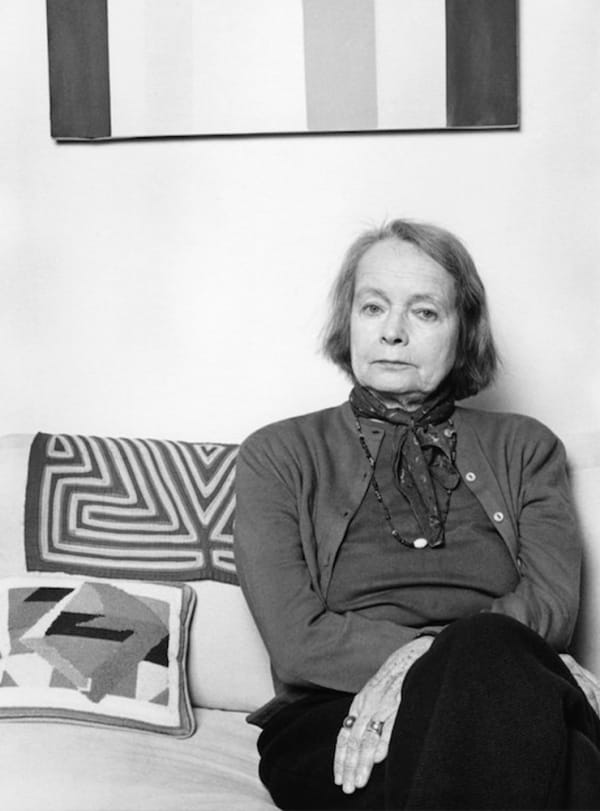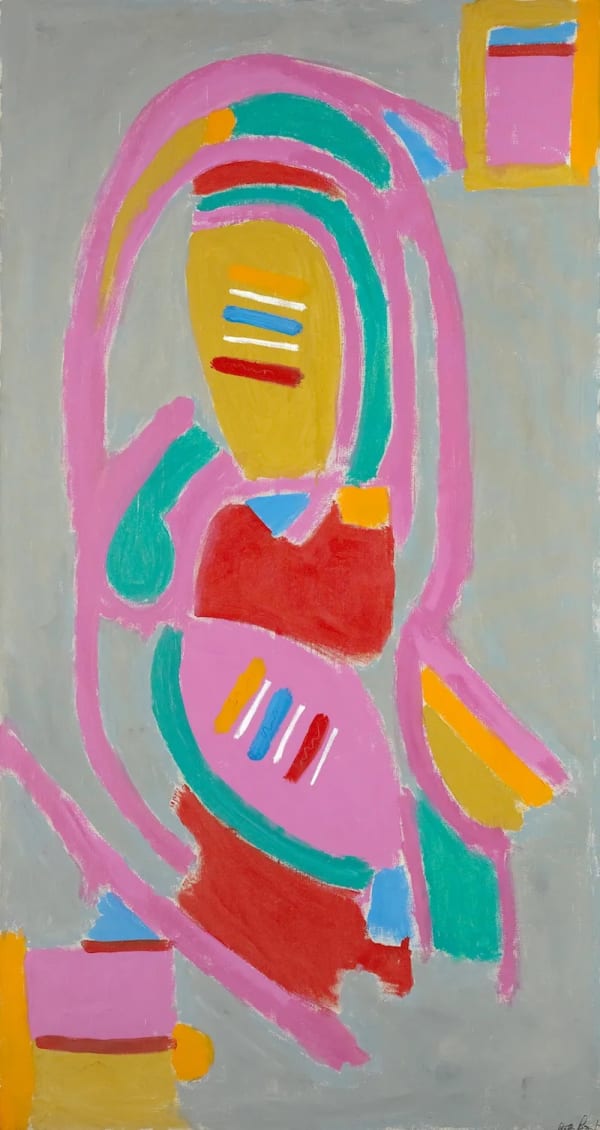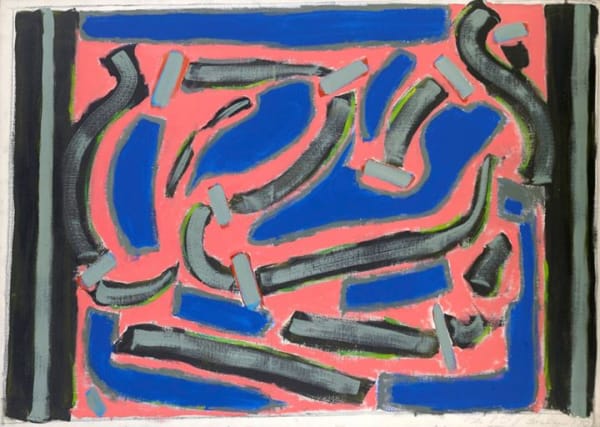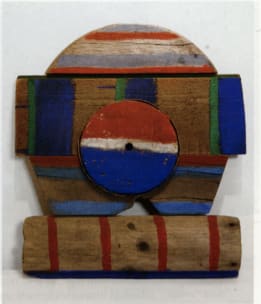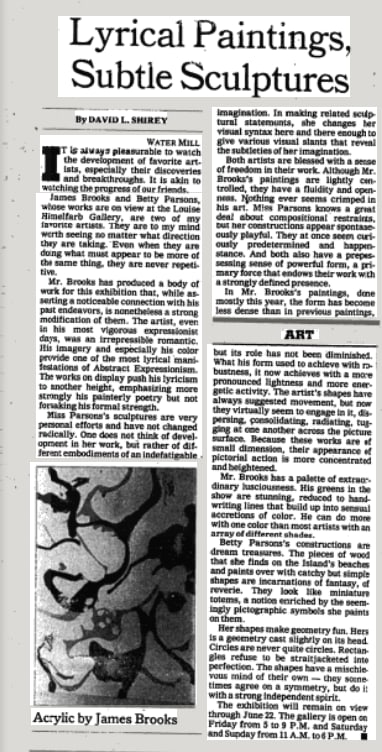Betty Parsons
-
Biography
Betty Parsons (b.1900, New York, NY – d.1982, Southold, NY) was an abstract painter and sculptor who is best known as a dealer of mid-century art. Throughout her storied career as a gallerist, she maintained a rigorous artistic practice by creating works in a variety of media including paintings, sculpture, and works on paper. Parsons’s eye for innovative talent stemmed from her own artistic training, and her commitment to championing new and emerging artists of her time impacted the canon of twentieth-century art in the United States.
Parsons realized her passion for art early in life when she attended the 1913 Armory Show in New York City. As she entered adulthood, however, she experienced the educational and professional limitations that faced women of her era. Tenaciously maintaining her desire to study art in all its forms, Parsons took lessons with artists in New York City throughout finishing school and during her three-year marriage to Schuyler Livingston Parsons. Upon its dissolution in 1923, Parsons moved to Paris and stayed for ten years to dedicate herself fully to the pursuit of art. At the Academie de la Grande Chaumière, she studied painting and sculpture first with Antoine Bourdelle and later Ossip Zadkine, alongside fellow student Alberto Giacometti. Through her expatriate community of friends and cultural figures —including Sylvia Beach, Gertrude Stein, and Adge Baker— Parsons continued her artistic education outside the classroom. She joined Baker in studying watercolor with Sir Arthur Lindsey and spent summers with them painting en plein air along the Brittany coast.
After returning to the United States in 1933, Parsons continued to create art both in California and New York. In 1935, she had her first solo exhibition of paintings at Midtown Galleries, New York. She then accepted a position there, installing works and selling paintings on commission which began to establish her professional identity as an art dealer.
Parsons opened her eponymous gallery in New York in 1946. After the closure of Peggy Guggenheim’s Art of This Century Gallery in 1947, she inherited Guggenheim’s roster of artists, including Barnett Newman, Mark Rothko, Jackson Pollock, and Clyfford Still. Although the legacy of the Betty Parsons Gallery is closely tied to these leading figures, Parsons showcased work by women, queer artists, and artists of color. Her diverse program reflected her liberal, inclusive values, and her profound sense of community.
While running her gallery, Parsons’s artistic practice was an ever-present constant. She began to render abstract works in the late 1940s in order to capture what she called “sheer energy” and “the new spirit.” Stylistically departing from her training as a sculptor and landscape artist, her paintings conveyed a passion for spontaneity and creative play through impulsive gestural brushstrokes and organic forms. She often applied thin layers of paint to allow for the canvas to remain visible, elevating its function from material to pigment. In addition, she employed the sgrafitto technique and scratched off the top layer of paint in select areas. Departing from verisimilitude, Parsons described this shift as an effort to capture not what a place or event “looked like, but what it made [her] feel.”
Throughout her life, Parsons traveled to various international locales, including Mexico, France, Italy, Africa, and Japan, to satiate her curiosity about the wider world around her. She prolifically recorded these trips as watercolors, sketches, drawings, and other entries in visual journals that number into the hundreds. The undulating brushstrokes and non-naturalistic pigmentation of these works show Parsons’s experimentation with these and other means to convey her distinctive sense of place.
Parsons commissioned designer and sculptor Tony Smith to construct her studio/residence in Southold, Long Island. After its completion in 1960, Parsons frequently traded the metropolis of New York City for the quiet of the Long Island Sound. Surrounded by nature in a creative haven of her own, her artistic output became more prolific and diverse. In addition to works on canvas —some of which she painted outside on the beach— Parsons began creating sculptures composed of driftwood she collected while walking along the shore. These painted wooden assemblages can be seen as amalgamations of her passion for sculpture, mastery of color, and connection to nature.
In 1977, Parsons coined the phrase “invisible presence” to describe the energy she experienced in any given setting, an energy that she attempted to capture in all forms of her artwork. This belief in an unseen force is a nod to her practice of non-Western spiritualism, including meditation, and her interest in mysticism and indigenous American art. Rather than subscribing to a rigid theoretical framework in both personal and artistic beliefs, Parsons’s abstraction allowed for expressive improvisation in her paintings, assemblages, and diaries. Her aesthetic development was not a linear progression, but rather one in which she established and then revisited artistic devices throughout her career.
By the time of her death in 1982, Betty Parsons had created a multi-faceted legacy that extended beyond her successful gallery career. Her activism took the form of championing women and other marginalized artists of her time as well as advocating for the health and preservation of our oceans. With her diverse exhibition history and unique artistic vision, she established herself as an artist in her own right and was an influential force in the art of the mid-twentieth century. A digital catalogue raisonné of her work is in production by the Betty Parsons and William P. Rayner Foundation.
Betty Parsons’s work has been the subject of numerous one-person exhibitions at Marion Art Center, MA (2022); Art Omi, Ghent, NY (2018); The Pollock-Krasner House and Study Center, East Hampton, NY (1992); the Montclair Museum of Art, NJ (1974); Whitechapel Gallery, London, United Kingdom (1968), and The Miami Museum of Modern Art, FL (1963). Parsons’s work is represented in prominent public collections including the Buffalo AKG Art Museum, NY; Carnegie Museum of Art, Pittsburgh, PA; Guild Hall, East Hampton, NY; High Museum of Art, Atlanta, GA; The Museum of Modern Art, New York, NY; National Museum of Women in the Arts, Washington, DC; Parrish Art Museum, Water Mill, NY; Smithsonian American Art Museum, Washington, DC; and Whitney Museum of American Art, New York, NY; among others.
-
Bodies of Work
-

Early Work
Parsons's early work is intimately tied to her travels—both around the United States and internationally—exploring destinations through both educational and recreational lenses. Throughout the 1920s, Parsons studied with sculptors Antoine... -

Works on Paper
In the years following 1947, Parsons made several hundred canvas paintings and even more works on paper. These dynamic, intimately scaled works foreground the artist’s signature approach: fortifying the nonrepresentational... -

Paintings
In the years following 1947, Parsons made several hundred canvas paintings. Across her canvases, she developed an idiosyncratic visual vocabulary built from her reevaluation of modernist gestures. They include bright,... -

Sculptures (1965–82)
Following the dissolution of her marriage to Schuyler Livingston Parsons in 1923, Parsons studied painting and sculpture in Paris at Antoine Bourdelle’s Academie de la Grande Chaumière, learning alongside Alberto...
-
-
Exhibitions
-

Betty Parsons
Reverberation February 14 - March 15, 2025 New YorkAlexander Gray Associates, New York presents Reverberation , the Gallery’s fourth exhibition of works by Betty Parsons (1900–1982), showcasing rarely seen paintings and works on paper from the 1960s. The...Read more -

I Spy
June 23 - August 27, 2023 GermantownAlexander Gray Associates, Germantown presents I Spy , a group exhibition of paintings, works on paper, and sculptures by Jennie Jieun Lee , Carrie Moyer , and Betty Parsons ....Read more -

"A sheet of paper casts a shadow."
September 16 - October 30, 2022 GermantownAlexander Gray Associates, Germantown presents 'A sheet of paper casts a shadow. ” This group exhibition features a selection of works on paper by six Gallery artists, Ricardo Brey, Luis...Read more -

Betty Parsons
1950s Works on Paper November 20, 2020 - January 31, 2021 GermantownAlexander Gray Associates, Germantown presented Betty Parsons: 1950s Works on Paper , its third exhibition of work by Betty Parsons (1900 – 1982). The Gallery’s presentation highlights a pivotal moment...Read more -

Betty Parsons
Heated Sky February 27 - August 14, 2020 New YorkAlexander Gray Associates presented its second exhibition of works by Betty Parsons (1900–1982), Heated Sky . The paintings and works on paper from the height of Parsons’ engagement with abstraction...Read more -

Count of Three
April 18 - May 24, 2019 New YorkAlexander Gray Associates presented Count of Three , a survey of abstract painting from the 1960s to the present that takes structure—both formal and metaphysical—as a position to work within...Read more -

Betty Parsons
Invisible Presence May 25 - July 14, 2017 New YorkAlexander Gray Associates presented its first exhibition of work by Betty Parsons (b.1900, New York City, NY – d.1982, Southold, NY), since recently becoming the representative of the Estate. The...Read more
-
-
Other Exhibitions
-

Betty Parsons: Sheer Energy
De La Warr Pavilion October 4, 2025 - January 18, 2026Betty Parson's solo exhibition Sheer Energy at the De La Warr Pavillion, Bexhill-on-Sea, East Sussex, United Kingdom. The institution's press release follows: Throughout her career, Betty Parsons (1900 – 1982)... -

Betty Parsons
Alison Jacques March 20 - April 27, 2024Betty Parsons's solo exhibition at Alison Jacques Gallery, London, UK. Alison Jacques's press release follows: I’ve always been fascinated with what I call ‘the invisible presence’. The most permanent thing... -

Action, Gesture, Paint: Women Artists and Global Abstraction 1940–70
Whitechapel Gallery February 9 - May 7, 2023Betty Parsons is included in the group exhibition Action, Gesture, Paint: Women Artists and Global Abstraction 1940–70 at Whitechapel Gallery in London, UK. Whitechapel Gallery's press release follows: Whitechapel Gallery... -

Friends in a Field: Conversations with Raoul De Keyser
Mu.ZEE December 17, 2022 - May 21, 2023Betty Parsons is included in the group exhibition Friends in a Field: Conversations with Raoul De Keyser at Mu.ZEE, Oostende, Belgium. The insitution's press release follows: Mu.ZEE invited the American... -

What You See Is What You Get
MASSIMODECARLO June 30 - July 30, 2022Betty Parsons included in the group exhibition What You See Is What You Get at Casa Corbellini-Wasserman in Milan and MASSMIODECARLO Pièce Unique Paris. The institution's press release follows: MASSIMODECARLO... -

Betty Parsons: The Queen of the Circus
Alison Jacques Gallery October 2 - November 9, 2019Betty Parsons's solo exhibition Betty Parsons: The Queen of the Circus at Alison Jacques Gallery, London, United Kingdom. The institution's press release follows: Alison Jacques Gallery is pleased to announce... -

Betty Parsons: Blue sky very high
Art Omi October 20, 2018 - January 6, 2019Betty Parsons's solo exhibition Betty Parsons: Blue sky very high at Art Omi, Ghent, NY. The institution's press release follows: Known to many as a champion of abstract expressionists like...
-
-
Public Collections
Addison Gallery of American Art, Andover, MA
Birmingham Museum of Art, AL
Buffalo AKG Art Museum, NY
Carnegie Museum of Art, Pittsburgh, PA
Denver Art Museum, CO
Heckscher Museum of Art, Huntington, NY
Herbert F. Johnson Museum of Art, Cornell University, Ithaca, NY
High Museum of Art, Atlanta, GA
Irish Museum of Modern Art, Dublin, Ireland
MIT List Visual Arts Center, Cambridge, MA
Montclair Art Museum, NJ
Museum of Fine Arts, Houston, TX
Museum of Modern Art, New York, NY
National Museum of Women in the Arts, Washington, DC
Parrish Art Museum, Water Mill, NY
Portland Art Museum, OR
RISD Museum, Providence, RI
Ruth and Elmer Wellin Museum of Art, Hamilton College, Clinton, NY
Smithsonian American Art Museum, Washington, DC
Telfair Museums, Savannah, GA
Whitney Museum of American Art, New York, NY -
News / Events
-

Betty Parsons
Abstract Expressionists: The Women at the Speed Art Museum May 16–August 30, 2026Betty Parsons's group exhibition, Abstract Expressionists: The Women at the Speed Art Museum, Louisville, Kentucky, will be on view May 16–Augsut 30, 2026Read more -

Betty Parsons
Abstract Expressionists: The Women at the Muscarelle Museum of Art at William & Mary January 23–April 26, 2026Betty Parsons's group exhibition, Abstract Expressionists: The Women at Muscarelle Museum of Art at William & Mary, Williamsburg, Virginia, will be on view January 23–April 26, 2026.Read more -

Betty Parsons: Sheer Energy
De La Warr Pavilion October 4, 2025–January 18, 2026Betty Parsons' solo exhibition, Betty Parsons: Sheer Energy at De La Warr Pavilion, Bexhill-on-Sea, East Sussex, United Kingdom, will be on view October 4, 2025–January 18, 2026.Read more -

Harmony Hammond, Carrie Moyer, Betty Parsons, and Joan Semmel
Flesh Flowers at the Aïshti Foundation October 27, 2025–January 1, 2026Harmony Hammond, Carrie Moyer, Betty Parsons, and Joan Semmel are included in the group exhibition Flesh Flowers at the Aïshti Foundation, Beirut, Lebanon, on view from October 27, 2025–January 1, 2026.Read more -

Betty Parsons
Abstract Expressionists: The Women at the Wichita Art Museum August 23–November 30, 2025Betty Parsons's group exhibition, Abstract Expressionists: The Women at The Wichita Art Museum, Kansas, will be on view August 23–November 30, 2025Read more -

Betty Parsons
All of Me with All of You: LGBTQ+ Art Out of the Collection at the Heckscher Museum of Art June 7–September 14, 2025Betty Parsons is included in the group exhibition All of Me with All of You: LGBTQ+ Art Out of the Collection at the Heckscher Museum of Art, Huntington, New York, on view from June 7–September 14, 2025.Read more -

"The Other Betty Parsons Gallery"
Lecture by Art Historian and Curator Rachel Federman February 15, 2025, 11:00 AMJoin us at Alexander Gray Associates, New York, for a lecture, “The Other Betty Parsons Gallery,” by art historian and curator Rachel Federman on Saturday, February 15, at 11:00 AM. The lecture is organized on the occasion of Betty Parsons: Reverberation, the artist’s fourth solo exhibition with the Gallery, showcasing rarely seen paintings and works on paper from the 1960s.Read more -

Betty Parsons
Artists Choose Parrish at Parrish Art Museum October 29, 2023–February 18, 2024Read moreBetty Parsons is included in a group exhibition, Artists Choose Parrish, at the Parrish Art Museum in Water Mill, New York.
-

Betty Parsons
Taking Space: Contemporary Women Artists and the Politics of Scale at Montclair Art Museum September 15, 2023–January 7, 2024Read moreBetty Parsons is included in a group exhibition, Taking Space: Contemporary Women Artists and the Politics of Scale at Montclair Art Museum, New Jersey.
-

Betty Parsons
Action, Gesture, Paint: Women Artists and Global Abstraction 1940–70 at Whitechapel Gallery February 9–May 7, 2023Read moreBetty Parsons is included in the group exhibition Action, Gesture, Paint: Women Artists and Global Abstraction 1940–70 at Whitechapel Gallery in London, UK.
-

Betty Parsons
Friends in a Field: Conversations with Raoul De Keyser at Mu.ZEE December 17, 2022–May 21, 2023Read moreBetty Parsons is included in the group exhibition Friends in a Field: Conversations with Raoul De Keyser at Mu.ZEE, Oostende, Belgium.
-

Betty Parsons
Kinship: Dusti Bongé and Betty Parsons at Hollis Taggart October 13–November 12, 2022Read moreBetty Parsons included in exhibition Kinship: Dusti Bongé and Betty Parsons at Hollis Taggart, New York.
-

Betty Parsons
Marion Art Center September 23–October 28, 2022Read moreBetty Parsons will have an opening reception at the Marion Art Center, MA followed by a presentation and conversation with Collections and Research Manager, Rachel Vorsanger.
-

Betty Parsons
What You See Is What You Get at Massimo De Carlo at Massimo de Carlo June 3–July 27, 2022Read moreBetty Parsons included in the group exhibition What You See Is What You Get at Casa Corbellini-Wasserman in Milan and Massimo de Carlo Pièce Unique in Paris.
-
-
Articles / Reviews
-

Beyond London, a Coastal County Where Art Abounds
The New York TimesOctober 3, 2025 The southeastern county of East Sussex is home to a wealth of independent galleries and exhibition spaces. London may be... -

What to See in N.Y.C. Galleries in March
The New York TimesMarch 6, 2025 This week in Newly Reviewed, Andrew Russeth covers Léon Spilliaert’s brooding pieces, Betty Parsons’s restless forms, Adriana Ramic’s beetles and... -

New York’s Top October Art Exhibitions Have A Southern Flavor
ForbesOctober 10, 2022 The pleasures of fall in New York City go beyond sweater weather, cute boots and pumpkin spice everything. Autumn in... -
![Betty Parsons (1900-1982) Devil in the [...], 1973 Signed and dated lower left: "Betty Parsons 73" Titled and dated verso: "Devil in the [...] 1973" Gouache on paper 11 3/4 x 9 in. (29.8 x 22.9 cm)](data:image/gif;base64,R0lGODlhAQABAIAAAAAAAP///yH5BAEAAAAALAAAAAABAAEAAAIBRAA7)
Hollis Taggart to Present First Exhibition to Capture Intimate Friendship Between Artist Dusti Bongé and Gallerist and Artist Betty Parsons
ARTFIX DailyOctober 6, 2022 Hollis Taggart will present Kinship: Dusti Bongé and Betty Parsons , an expansive exhibition on the illustrious but lesser-known career... -

Artists to see first at Frieze Seoul, chosen by 6 experts
Esquire KoreaSeptember 14, 2022 ALEXANDER GRAY ASSOCIATES BETTY PARSONS Here comes the work of an artist I have long liked and wanted to become... -

5 Fast Facts: Betty Parsons and #5WomenArtists
National Museum of Women in the ArtsFebruary 17, 2022 Betty Parsons (1900–1982), American artist and New York City (NYC) gallerist, was known as the “den mother of Abstract Expressionism.”... -

9 Art Exhibitions Worth Masking Up for This Spring
VogueMarch 19, 2021 In New York, most museums and galleries reopened some time ago, but with the zing of spring now in the... -

The super-gallerist putting women in the picture
Financial TimesNovember 18, 2020 “Strong women intent on doing their own thing are like magnets for me, I gravitate towards them and their work... -

The Art Scene: 02.27.20
East Hampton StarFebruary 27, 2020 Betty Parsons in Chelsea Alexander Gray Associates in Chelsea will present “Heated Sky,” an exhibition of paintings and works on... -

Editors’ Picks: 21 Things Not to Miss in New York’s Art World This Week
artnet NewsFebruary 24, 2020 8. “Betty Parsons: Heated Sky ” at Alexander Gray Associates The overdue rediscovery of the artistic practice of the late... -

Your Concise New York Art Guide for Spring 2020
HyperallergicFebruary 18, 2020 Happy spring! Each season, New York’s art community consistently offers a range of exciting exhibitions, performances, film series, and other... -

Heckscher's 'Locally Sourced' exhibit spotlights LI artists
NewsdayDecember 3, 2019 Hans Namuth’s iconic shots of Jackson Pollock at work in his Springs studio gave the world a critical behind-the-scenes glimpse... -

Critics' Picks: Betty Parsons
ArtforumOctober 22, 2019 What to write, in this jewel-size space, of Betty Parsons ’s riotous, jewel-hued paintings, or of her vibrant driftwood assemblages?... -

A Show Focused on One Renowned Dealer’s Own Unsung Art Practice
T, the New York Times Style MagazineOctober 3, 2019 Perhaps best known as an art dealer who discovered and promoted the work of the Abstract Expressionist painters, Betty Parsons... -

Betty Parsons the Painter
FriezeOctober 1, 2019 In 1977, the American art dealer and artist Betty Parsons appeared on the TV show About the Arts . She... -

In London for Frieze Week? Don’t Miss These 15 Must-See Gallery Shows During the Fair
artnet NewsSeptember 30, 2019 Frieze Week in London is upon us once more, and there’ll be no shortage of gallery exhibitions, art fairs, and... -

What to see at Frieze 2019: the artists and galleries not to miss
Harper's BazaarSeptember 28, 2019 The highlight of the art-world calendar, Frieze London and Frieze Masters come to London from 3 to 6 October, bringing... -

Frieze week highlights: the Goya of Aberdeenshire and Cézanne in one piece
Apollo MagazineSeptember 27, 2019 With hundreds of exhibitions and events vying for your attention in London during Frieze week, Apollo’s editors pick out the... -

Frieze Week Lowdown: London Shows to See in 2019
OculaSeptember 20, 2019 Betty Parsons Alison Jacques Gallery, 16–18 Berners Street, W1T 3LN 2 October–9 November 2019 Once known as the 'den of... -

Betty Parsons one of the most influential and dynamic figures of the American avant-garde.
FAD MagazineAugust 6, 2019 Alison Jacques Gallery to present an exhibition of works by Betty Parsons (1900 - 1982), one of the most influential... -

The Artists Who Summered on Long Island
The New YorkerJuly 8, 2019 During the summer months of the mid-twentieth century, the epicenter of the New York School shifted from the Cedar Tavern,... -

Barry Bergdoll showcases a new wave of modern architecture on Long Island
The Architect's NewspaperJuly 8, 2019 The “North Fork” of Long Island , from the town of Riverhead to Orient Point at the eastern tip, is... -

South Fork Women: Female Abstract Expressionists at Kasmin
Less than HalfJuly 1, 2019 Long before it was colonized by mansions on postage stamps of land, the Hamptons were an artists’ bohemia. While its... -

Game Changer: Betty Parsons
Gagosian QuarterlyMarch 5, 2019 Betty Parsons wasn’t an extraordinary businessperson. She spent little time thinking about profits: “I’ve always been given the vision to... -

The Legendary Betty Parsons Meets the Not-So-Legendary Betty Parsons
HyperallergicJuly 8, 2017 Betty Parsons (1900-1982) is the legendary dealer who, after opening her gallery in 1946, gave shows to Barnett Newman, Jackson... -

Pioneering Gallerist Betty Parsons Was Also an Important Artist
ArtsyJune 23, 2017 The list of Betty Parsons ’s adventures and accomplishments is immense. As a gallerist, she gave Jackson Pollock , and... -

From the Archives: Betty Parsons, Gallerist Turned Artist, Takes the Spotlight, in 1979
ARTnewsJune 16, 2017 When art historians mention Betty Parsons, they’re usually talking about her New York gallery, which, in the 1940s, ’50s, and... -

Estate of Betty Parsons, Storied Ab Ex Dealer Who Also Made Art, Goes to Alexander Gray Associates
ARTnewsMarch 16, 2017 Betty Parsons may be better known for her gallery, which, in the 1950s, was responsible for showing the “Four Horsemen”... -

The Parsons Effect
Art in AmericaNovember 1, 2013 I was so interested in other artists, it always cooled me off on myself. When I’m not at the gallery,... -

Best of 2008: Betty Parsons
ArtforumDecember 5, 2008 The biographies of New York School artists are often sprinkled liberally with the name of Betty Parsons, who is acclaimed... -

Painter Who Championed Others Gets Her Due
The New York TimesAugust 26, 2006 Betty Parsons, who died in 1982 at the age of 82, was one of the most recognizable figures in the... -

Artist With an Eye For Others' Work
The New York TimesFebruary 28, 1999 A FRIEND to many, and admired for her elegance, loyalty and tact, Betty Parsons has long had a niche in... -

Lyrical Paintings, Subtle Sculptures
The New York TimesJune 17, 1979 WATER MILL IT is always pleasurable to watch the development of favorite artists, especially their discoveries and breakthroughs. It is... -

A Keeper of the Treasure
The New YorkerJune 9, 1975 PROFILE of Betty Parsons, 75, N.Y. art dealer. The Betty Parsons Gallery is at 24 W. 57 St. Describes her... -

Betty Parsons Exhibits in Montclair
The New York TimesMarch 31, 1974 MONTCLAIR—Betty Parsons, one of the more celebrated of Manhattan's artdealers, is known less as a painter and sculptor in her...
-





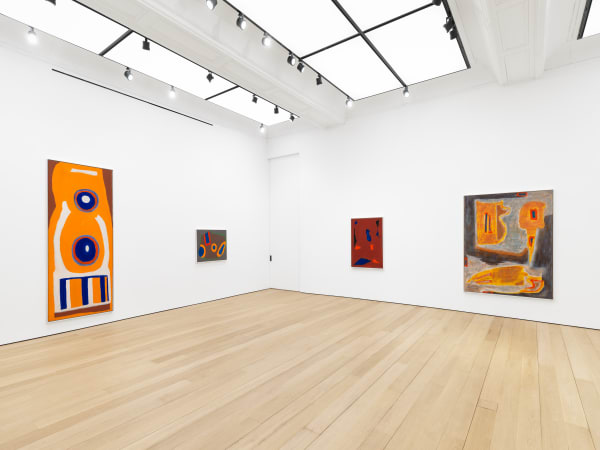





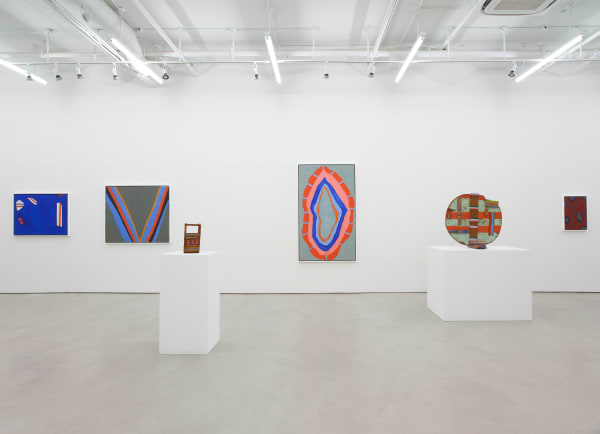

























![Betty Parsons (1900-1982) Devil in the [...], 1973 Signed and dated lower left: "Betty Parsons 73" Titled and dated verso: "Devil in the [...] 1973" Gouache on paper 11 3/4 x 9 in. (29.8 x 22.9 cm)](https://artlogic-res.cloudinary.com/w_600,c_limit,f_auto,fl_lossy,q_auto/ws-alexandergray/usr/images/press/main_image/items/14/14d531fee81e475aba4a61dd6b403f07/betty_parsons_-_htg17522_-_4000495x650.jpg)






